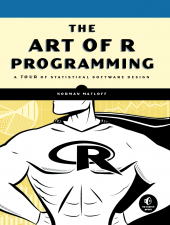It’s difficult to write a book on an entire programming language and keep it manageable and concise, but The Art of R Programming does it as well as any text I’ve seen. Matloff covers, in detail and among other things, R data structures, programming idioms, performance enhancements, interfaces with other languages, debugging and graphing.
Author(s): Norman Matloff
Publisher/Date: No Starch Press/2011
Statistics level: Very Low
Programming level: Intermediate
Overall recommendation: Highly Recommended
There is the requisite “Introduction to R” section that is present in almost all R texts, but any beginners who benefit from this chapter may benefit from re-reading ARP after some additional practical experience with R. The issues that Matloff addresses and the solutions he provides are more salient after you’ve spent hours trying to resolve them.
The section on graphing is a good overview, but the average programmer may find it less useful than the other sections. Anyone looking for graphic optimization tips will be better served by a book focused specifically on graphing.
With that minor critique in mind, put simply, The Art of R Programming is a must read for all intermediate level R programmers. It covers nearly every method of performance enhancement available and provides a review of key fundamentals that may have been forgotten or missed.
 One point of note, this text focuses almost solely on programming – the statistical examples are a means to an end, not an end themselves. For that reason, this book is recommended for those seeking to improve the efficiency of their programming rather than their statistical acumen.
One point of note, this text focuses almost solely on programming – the statistical examples are a means to an end, not an end themselves. For that reason, this book is recommended for those seeking to improve the efficiency of their programming rather than their statistical acumen.
At around ~$25 USD from Amazon, The Art of R Programming is one of the best R text values available. I highly recommend it for almost all R users. (You can also purchase this book directly from the publisher and get both the print and e-book version for ~$45.)